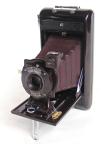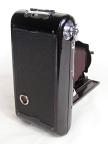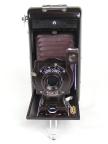Soho Cadet Camera
Soho Ltd
| Name: | Soho Cadet |
| Type: | Folding Rollfilm |
| Manufacturer: | Soho Ltd |
| Country of Origin: | United Kingdom |
| Construction: | There Soho Cadet is a folding bed rollfilm camera of conventional form, but made of
bakelite, generally in a maroon colour. It has a brilliant viewfinder and tripod bush. It is fitted with a simple focus scale to allow the lens position to be set for 'near' and 'far'. The camera was available initially with a simple menisucus lens and time & instantaneous shutter, but later further models were produced with better lenses and shutters (see Notes). |
| Plate / Film Size: | 120 rollfilm |
| Movements: | None |
| Dimensions (w x h x l): | |
| Production Period: | Unknown (see Notes) |
| Lens: | Meniscus (fixed aperture) |
| Shutter: | T & I (single speed) |
| Date of this Example: | c1932 |
| Serial Number: | None |
| Availability: |
|
| Inventory Number: | 427 |
|
Photos copyright © 2023 David Purcell. Do not use without permission. |
Description
The Soho Cadet is a maroon coloured bakelite folding-bed camera for pictures 3¼ x 2¼ inches (or 6 x 9 cms) on 120 rollfilm. This example is in good condition and is complete with its original box. The box is worn and faded, but is complete, although the surface of the main slip over sleeve is damaged.
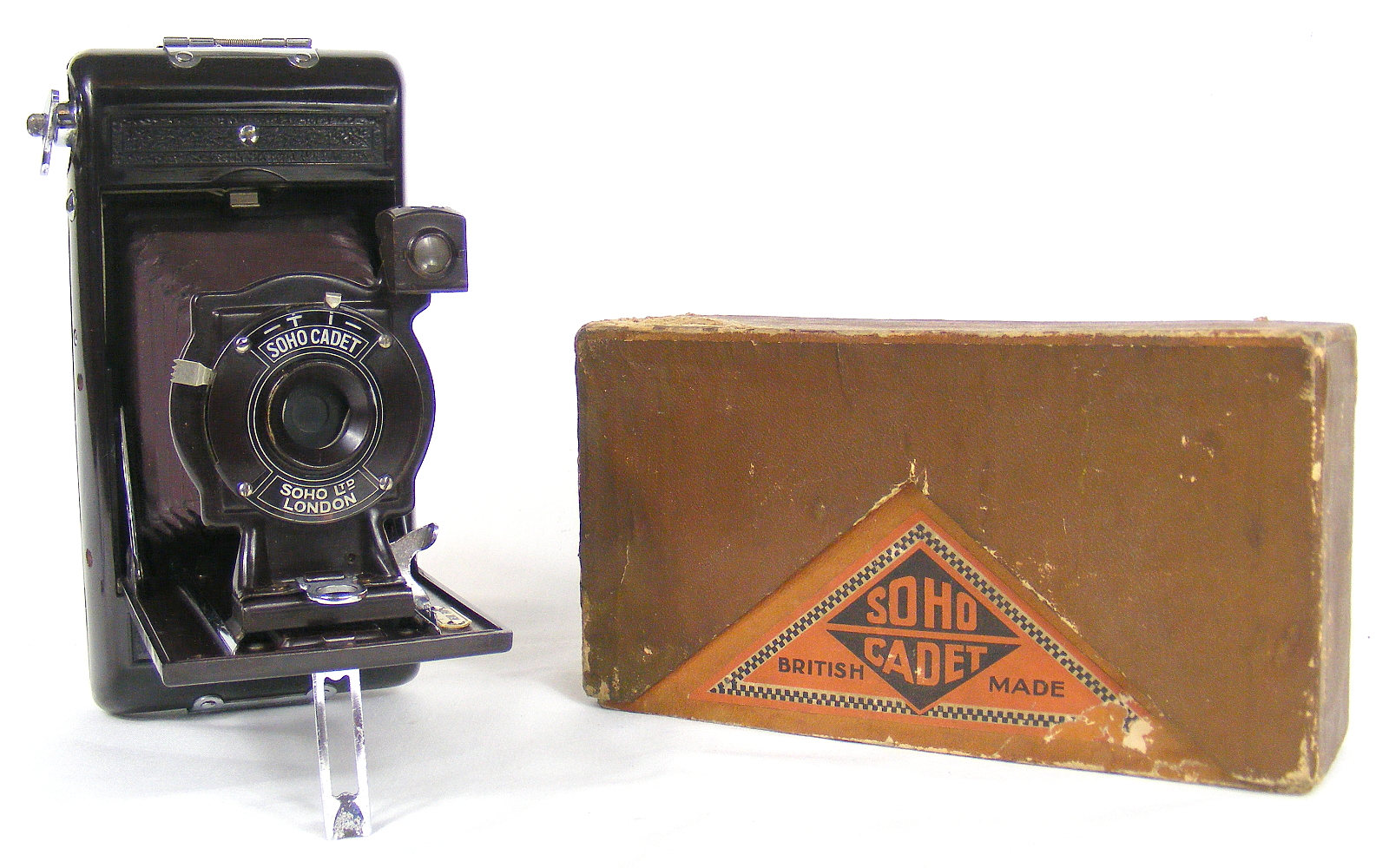
The Soho Cadet is advertised in the BJPA for 1932 (p36). It isn't mentioned in the 1933 edition, but by 1934 the Soho advertisement indicates that two versions of the camera were available: one with a simple meniscus lens (as the example here) and a more expensive version fitted with a doublet lens (BJPA 1934, p41 and p294). In the 1932 advertisement the camera is described as having a "Rosewood design moulded body".
Inside the back of the camera it is marked with patent 330438/29, which apparently relates to the use of a stencil to cut the bellows.
~ # ~ # ~
| Lens: | Meniscus (4 stops) |
| Shutter: | T & I (single speed) |
| Date of this Example: | c1933 |
| Serial Number: | None |
| Availability: |
|
| Inventory Number: | 683 |
Description
This is an example of a later enhanced version of the basic model fitted with an inset wheel set into the shutter assembly offering a choice of four different apertures, numbered 1 to 4. In other respects it is essentially identical to the basic model shown above, although there are some other minor differences.
Unfortunately this example has suffered some damage to the front edge of the shell of the fold down baseboard, as can be seen in the photo.
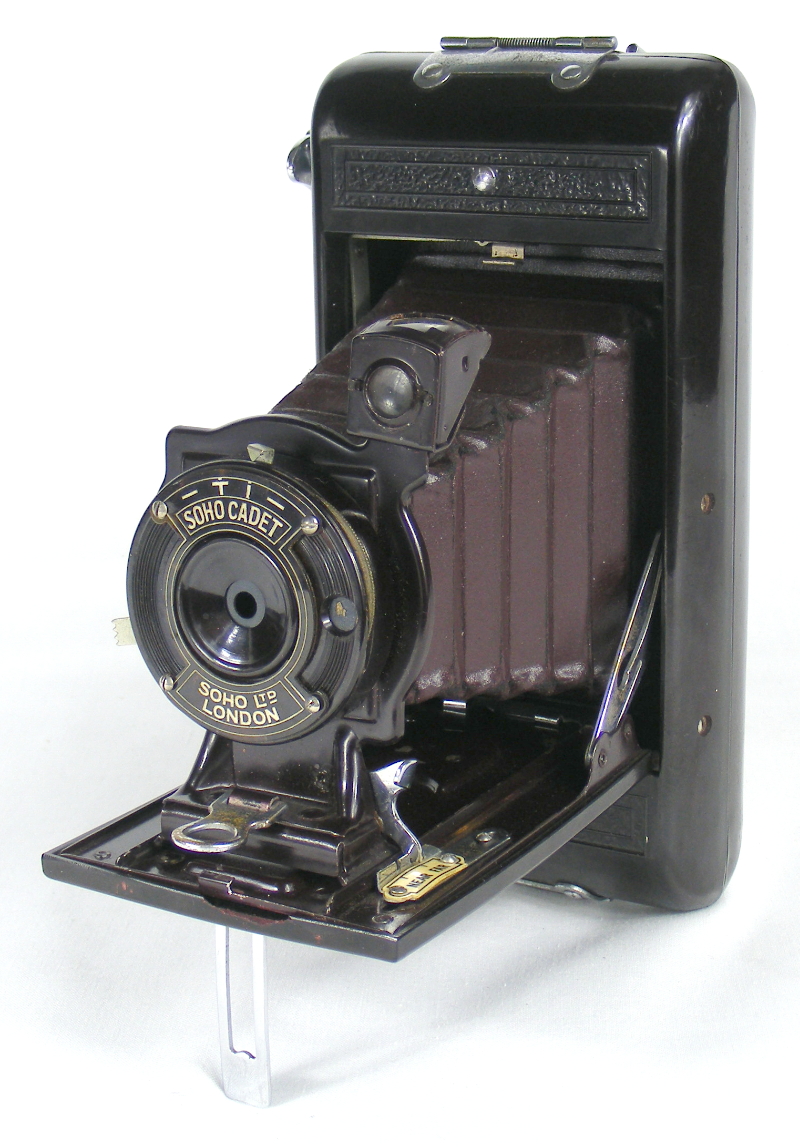
The photo below shows a front view the two versions of the basic model of the Soho Cadet camera with the simple meniscus lens (#427 on the left, and #683 with the 4-stop aperture wheel on the right). Aside of the aperture wheel, the only obvious differences between the two versions in this photo are that the text on the shutter plate is a creamy yellow colour on #683 rather than white, and #683 has a different focus scale mounting that allows the scale position to be adjusted. The latter is probably a design change that was made to allow the same baseboard to be used with the later production models that offered a choice of lenses (see Notes below).
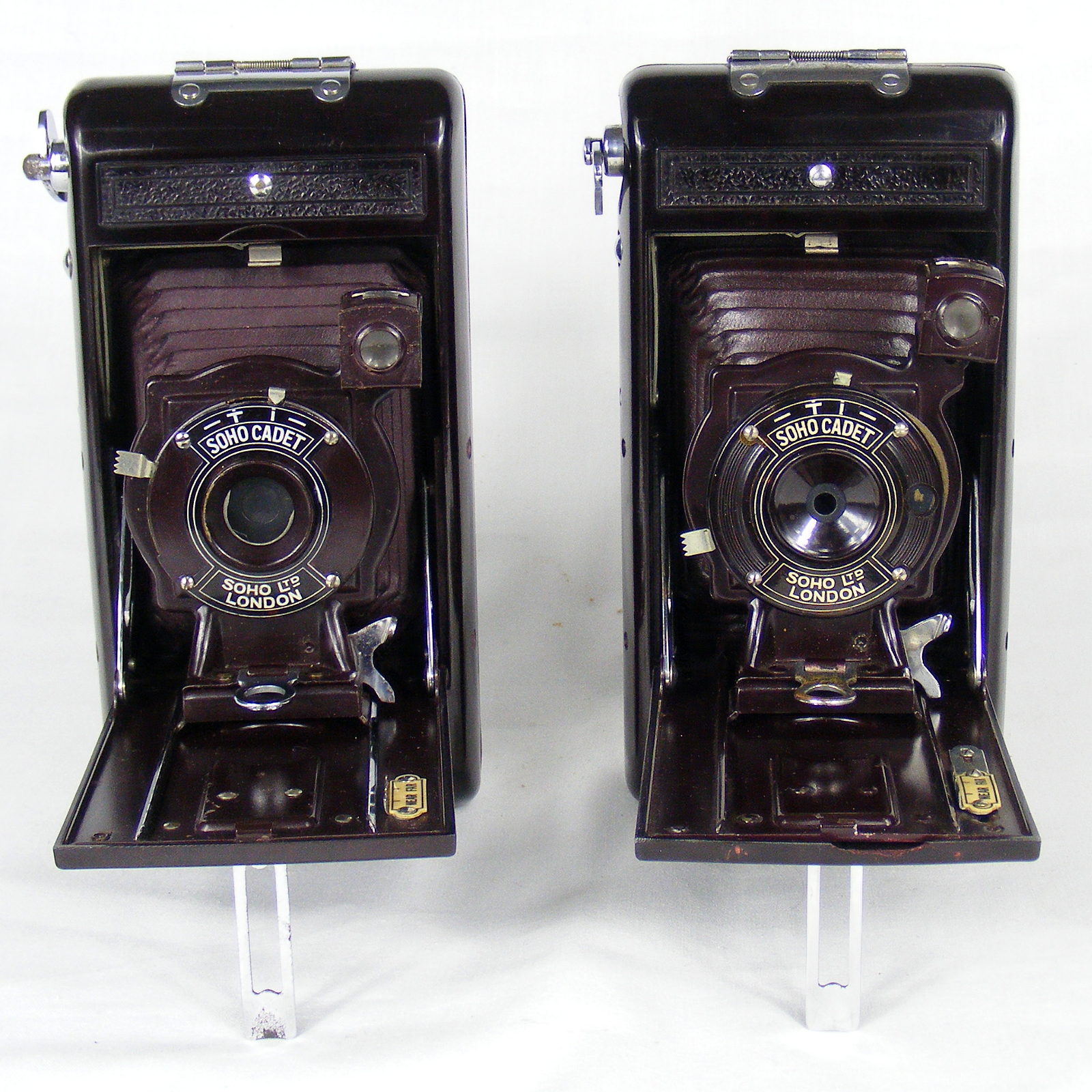
The photo below shows the back of the two camera bodies (again #427 is on the left). Again there are a number of differences. The most obvious is the fact that the earlier model on the left has leatherette flaps fixed to each side, which I believe to be original to the camera. Unfortunately I do not have a copy of the corresponding instruction booklet to be able to confirm their purpose, but note the small square hole at bottom left that coincides with the red window. I have not seen this feature on any other example of the camera (yet).
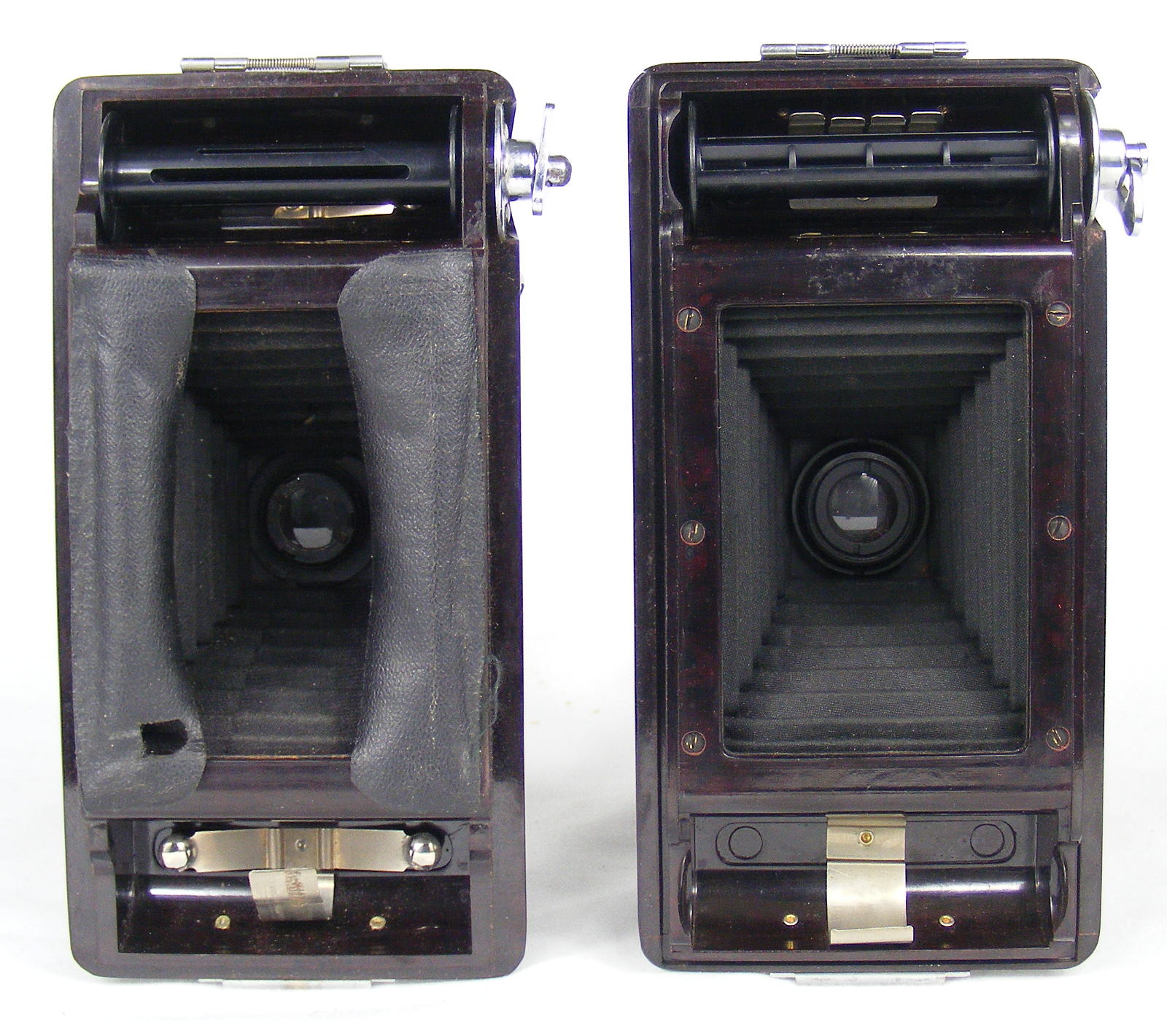
There are also some minor differences in the design of the spring clips used to hold the film spool firmly in place. The removable camera backs appear to be identical, although they are not actually interchangeable, as there is another subtle change in the design. The rear face of the camera body on the older model is completely flat, as is the mating surface on the inside of the removable camera back. On the later version, there is a narrow gulley around the inner edge of the face of the camera body where the two halves of the back meet, and a corresponding ridge on the mating face of the removable camera back. I presume this design is aimed at ensuring the two halves of the camera body are correctly positioned before closing the fastener, althoughit would also ensure the joint is lightproof.
There was at least one other variation to the moulding of the main body components during the production life, hereby metal strips were fixed to either side of the body, set into recesses in the main body shell. These strips were either painted to match the camera, or were chrome plated. I am of the view that this change came between the two versions of the moulding shown above. To see an example of this design of moulding, refer to the Soho Model B camera page.
~ # ~ # ~
| Lens: | Kershaw anastigmat f6.3 |
| Shutter: | Gauthier Vario shutter with three speeds 1/25, 1/50 and 1/100 plus Time, Bulb and delayed action |
| Date of this Example: | c1933 |
| Serial Number: | None |
| Availability: |
|
| Inventory Number: | 684 |
Description
This is a late example of the Soho Cadet camera and the most expensive variant, fitted with the Kershaw anastigmat f6.3 lens in a Gauthier Vario shutter. In other respects it is essentially identical to the basic model shown above, although there are some other minor differences.
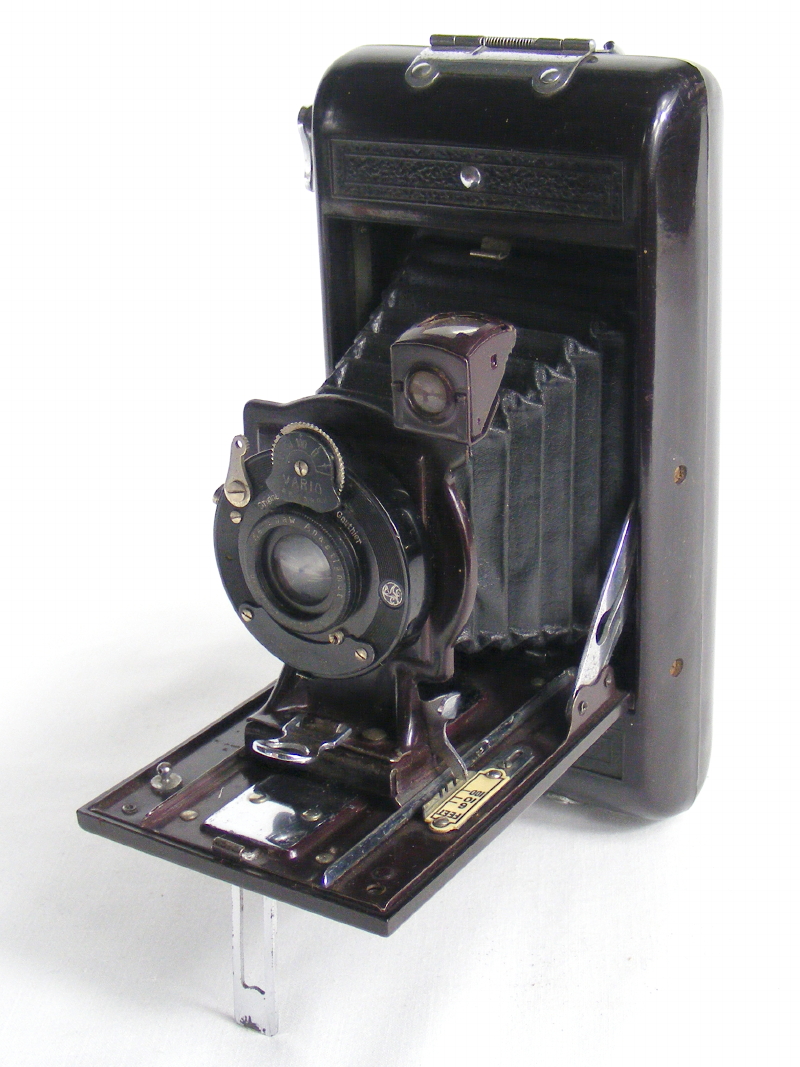
One of the minor differences is in the positioning and format of the focus scale. The scale is set further back than on the basic model due to the difference in the focal length of the Kershaw anastigmat lens, but also has three preset focus positions for 6ft, 10ft and 100ft.
The shutter has a delayed action function, which was achieved by inserting a tiny pin into the hole in the front of the shutter that can be found just above the 6.3 marking on the aperture plate. After pressing the shutter release, it would not actually fire until the pin was removed. So for a self-portrait, a length of thread might be attached to the pin that the subject could then pull once they were settled in position to fire the shutter. When not in use the pin was held in a holder on the left side of the baseboard. The pin is missing on this example, as I suspect it will be on most if not all examples you are likely to encounter. The photo below shows a close up of the shutter and lens.
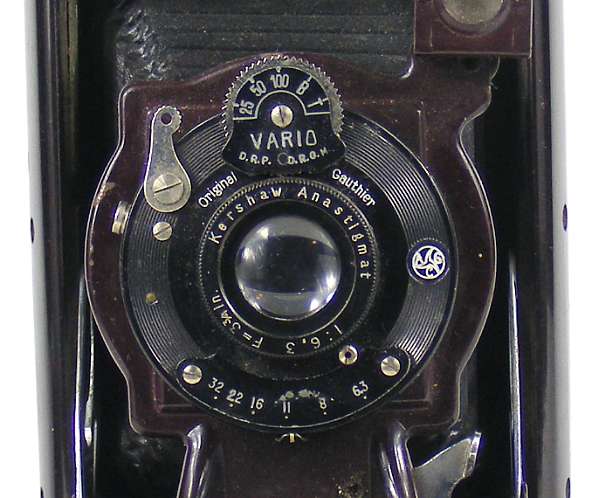
Notes
The Soho Cadet first appears in company advertising in 1931. I have not been able to establish when production of the camera ceased. While all examples I have seen have had maroon coloured bodies, there is evidence to suggest that some were made with black bakelite bodies.
The majority of cameras that turn up are the basic model, as the first example on this page, with the meniscus lens and simple single speed T & I shutter. According to John Vaughan in the Kershaw Camera Story, by 1933 the following more expensive versions of the Soho Cadet camera were also produced that offered better quality lenses:
- Kershaw doublet lens of fixed aperture, but later with a four stop aperture wheel
- Kershaw anastigmat f6.3 lens in a Gauthier Vario shutter with three speeds 1/25, 1/50 and 1/100 plus Time, Bulb and delayed action (as #684 above)
The 1934 BJPA (p194) describes the introduction of a new camera called the Tuon, based on the Cadet but taking 16 pictures of vest pocket size on 120 film, the camera having two red windows on the rear for the purpose and an internal blanking plate to halve the image size. Like the Cadet, the Tuon was also available with various lens/shutter options. The majority of the components were shared with the Cadet, to the extent that the same baseboard is used that has the words 'Soho Cadet' imprinted around the tripod bush.
![[x]](../../images/checked.png)
![[ ]](../../images/unchecked.png)
